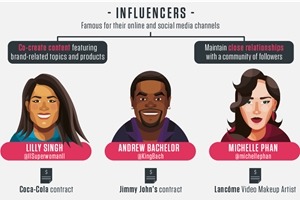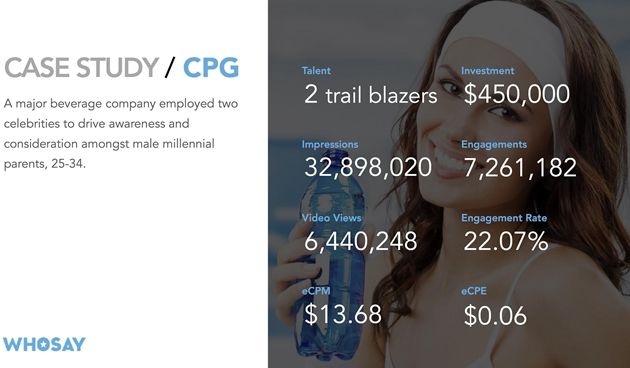
Today, few terms are as buzzy as influencer marketing… from top-trends lists to Cristiano Ronaldo generating nearly $1 billion through social media and right down to a 325% increase in searches for “influencer marketing” over the past year.
To move beyond the buzz, I recently connected with a host of upfront and behind-the-scenes authorities to track the past, present, and future of influencer marketing. Below, you’ll find a gorgeous walkthrough—in infographic form—on the “evolution of the influencer,” courtesy of the talented people at NoGRE and NowSourcing.
But before we turn to the big picture, let’s look at three challenging trends facing the industry of influence, along with how to fix them.
1. The Need for Influencer Attribution
“Gone are the days of blindly throwing money at top-funnel metrics like views, reach, and impressions,” says Travis Hawley, VP of business development at Viral Nation, “‘Influencer marketing’ may be buzzwords, but here’re two that matter more: bottom line.”
Marketing attribution—tracking performance and results—has always been a challenge. The ethereal nature of social media has only intensified it. But that doesn’t mean influence is impossible to quantify—if you know where to look.
On this front, Steve Ellis, CEO and founder at WHOSAY—an influencer-marketing company that’s worked with brands like Coca-Cola, Google, and Starbucks—stresses the need for accountability: “Influencers are a form of media, and media performance is measurable.”
“When brand dollars are on the line, it’s imperative that the campaign’s results are transparent, optimized, and measured by eCPM (effective cost per thousand impressions), eCPV (effective cost per view), eCPC (effective cost per click), and other metrics, including engagement, sentiment, and installs.”
As a starting point for prioritizing those metrics, consider WHOSAY’s template:

For tracking, influencers should make their native social analytics available to brands, but businesses themselves should take control of the bottom line by using UTMs, Google’s URL shortener, and—as old school as it might sound—campaign-specific coupon codes.
2. The Underutilized Power of Micro-Influencers
Iconic celebrities, professional athletes, and social-media rock stars are one thing.; the trouble is that those kinds of influencers are normally far beyond the budgetary realm of most businesses.
Enter the micro-influencer.
Micro-influencers are typically defined as social-media leaders with 1,000 to 5,000 followers. But don’t let the size of their audience fool you. An Experticity study led by Dr. Jonah Berger found that micro-influencers “have up to 22.2 times more conversations each week regarding recommendations on what to buy versus an average consumer.” What’s more, 82% of consumers are “highly likely to follow a recommendation made by a micro influencer.”
Not only that, but micro-influencers charge considerably less than their mainstream counterparts, according to Bloglovin’:

All this means “you can attain the same or larger reach when spread across a handful of micro-influencers for a fraction of the cost, while adding a more diverse, yet targeted audience,” as Troy Osinoff, author and head of customer acquisition at Buzzfeed, explains.
The key is aligning your values and product with micro-influencers and their niches.
3. The Struggle of B2B Influence
Perhaps the thorniest area of influencer marketing—or at least the most misunderstood—is business to business. Though social media is a powerhouse for direct B2C sales, few organizations have mastered its role in B2B.
Much of this struggle stems from a preoccupation with the second “B” in B2B. Longer sales cycles, multiple decision-makers, and the difficulty of overcoming organizational inertia all conspire to make social media feel irrelevant in B2B.
And yet, that’s precisely where an influencer’s strength lies: overcoming inertia not through better deals and pitches… but relationships. In the words of Mari Smith, author of The New Relationship Marketing: “To quote Seth Godin, people can ‘smell the agenda of a leader.’ This has never been more true than when it comes to influencer marketing. To maintain fiercely loyal fans, you must absolutely love and believe in what you’re endorsing. Value must align between you, the brand, the product, and your own audience.”
As Michaela Alexis—whose LinkedIn posts regularly earn hundreds of comments and hundreds-of-thousands of views—put it to me, relationships are all the more vital in B2B ecommerce and online sales: “It doesn’t matter whether you are selling to a receptionist or executive, everybody’s challenges are distinctly human. When I started sharing the messy parts of my career, the decision-makers from every level were instantly drawn in: first, becoming my followers and, eventually, my clients.
“The same is true for influencer marketing. Focus on co-creating narrative, real-life-driven content that addresses the human struggles your audience faces. Don’t be heavy-handed with product placements; instead, develop trust. That’s what influence is all about.”
 Image via Michaela Alexis and Shopify Plus
Image via Michaela Alexis and Shopify Plus
The Evolution of the Influencer: Past, Present, and Future
Of course, to truly understand a trend as dominant as influencer marketing, it’s vital to understand its roots and current expressions. This infographic, mapping out that development, originally appeared on Mashable.
Join over 600,000 marketing professionals, and gain access to thousands of marketing resources! Don’t worry … it’s FREE!

